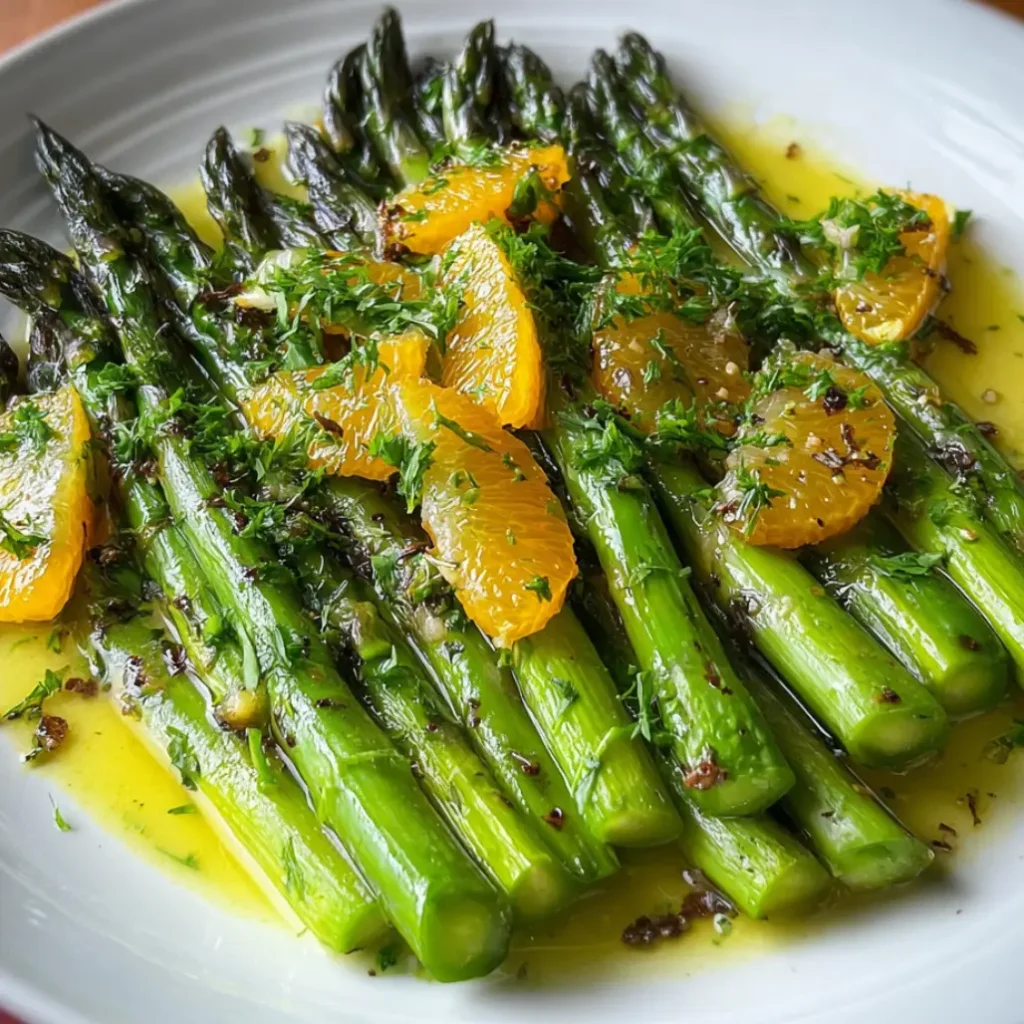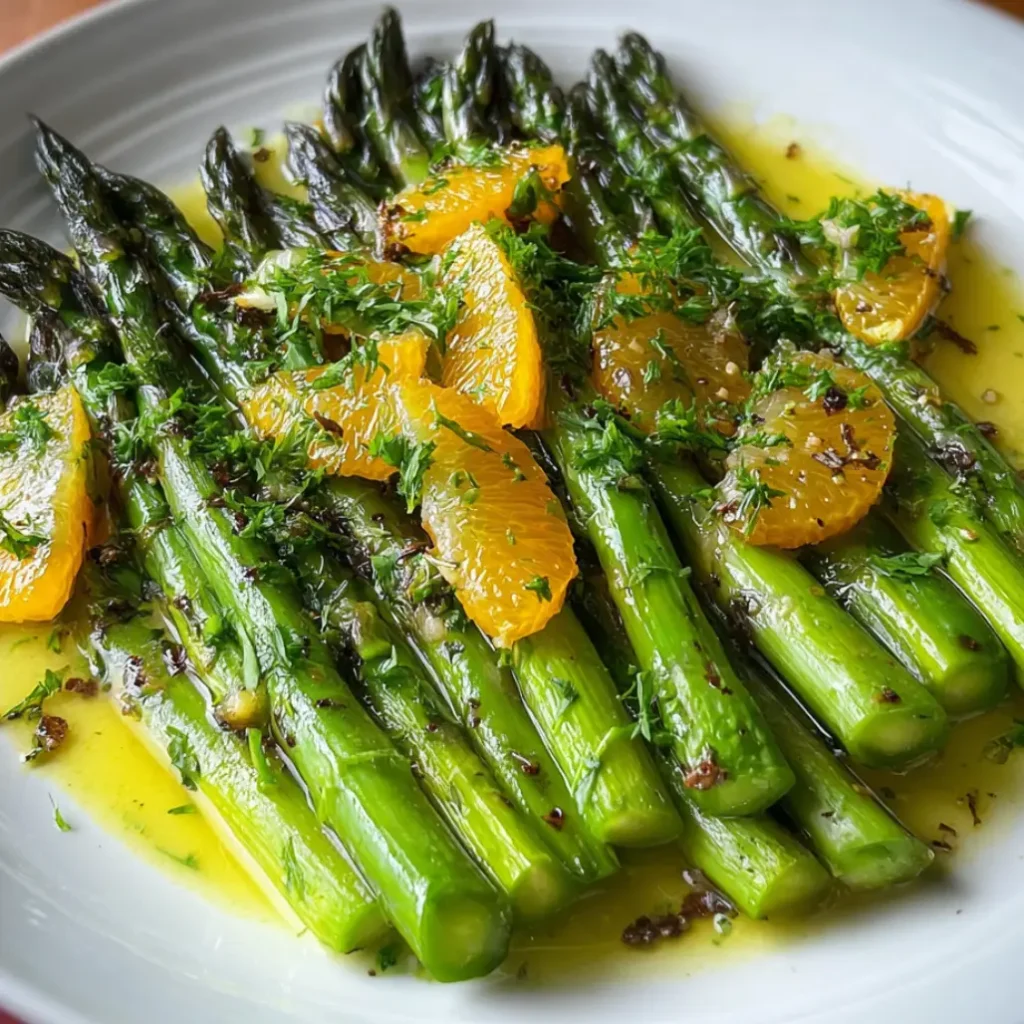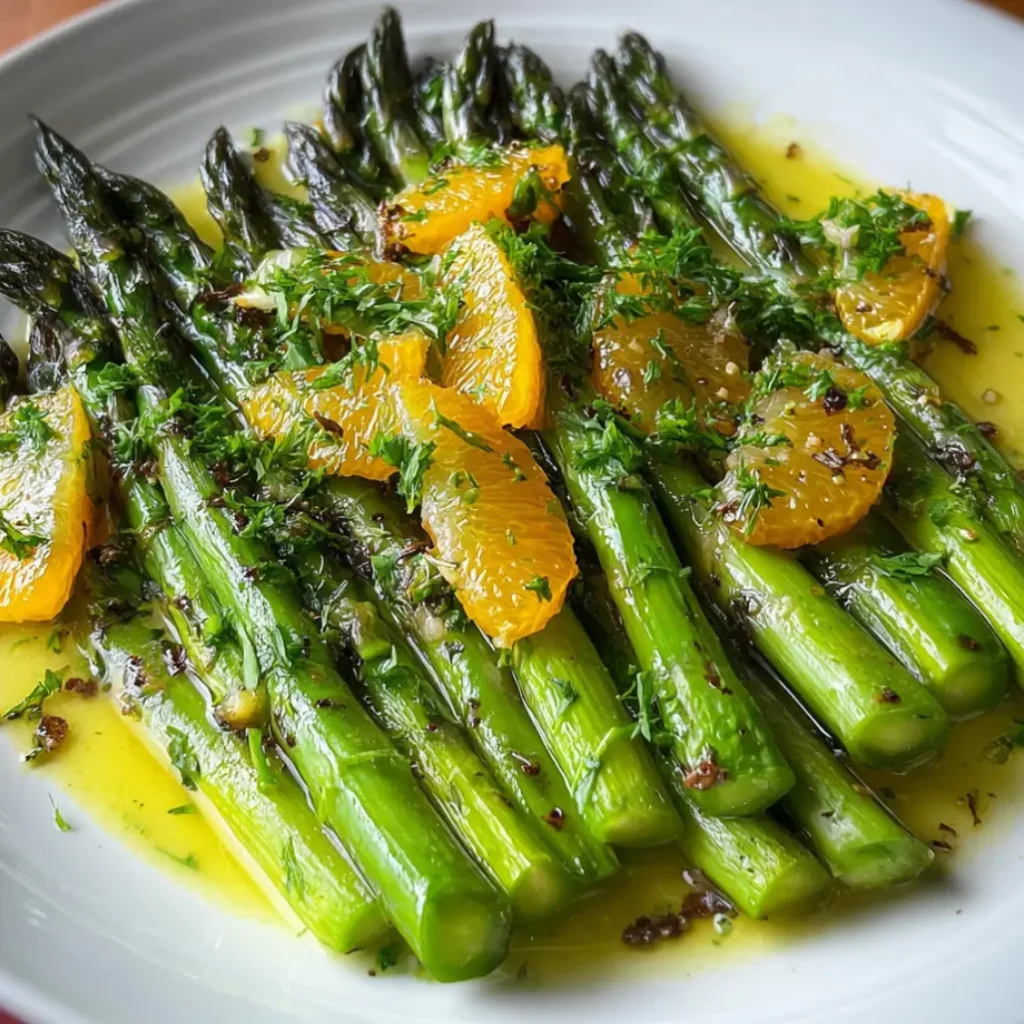| Prep Time: | 15 minutes |
|---|---|
| Cook Time: | 20 minutes |
| Total Time: | 35 minutes |
| Serves: | 4 |
Picture this elegant roasted asparagus tangerine gastrique emerging from your kitchen like a sophisticated restaurant creation, because this exceptional recipe transforms simple spring vegetables into a gourmet masterpiece that balances sweet, sour, and earthy flavors in perfect harmony. This remarkable roasted asparagus tangerine gastrique combines tender-crisp asparagus spears with a glossy, amber-colored sauce that delivers bright citrus notes because the French gastrique technique creates an intensely flavored reduction that elevates ordinary vegetables into extraordinary culinary experiences.
Why Roasted Asparagus Tangerine Gastrique Creates Culinary Magic
This sophisticated roasted asparagus tangerine gastrique works so beautifully because it employs classic French cooking techniques that concentrate flavors while maintaining the natural integrity of seasonal ingredients. The roasting process intensifies the asparagus because high heat caramelizes the natural sugars in the vegetables, creating complex nutty undertones that contrast beautifully with the bright acidity of the tangerine gastrique.
The gastrique itself represents culinary artistry because this traditional French sauce balances sweet caramelized sugar with tart citrus juice and vinegar, creating a glossy reduction that coats each asparagus spear with intense flavor. The tangerine component adds seasonal freshness because citrus fruits provide natural acidity that cuts through any richness while contributing bright, uplifting notes that make this roasted asparagusCategories tangerine gastrique feel both elegant and refreshing.
This recipe succeeds as both a sophisticated side dish and an impressive appetizer because the presentation appears restaurant-quality while the preparation remains accessible to home cooks. The vibrant green asparagus spears drizzled with golden gastrique create visual appeal because the color contrast suggests spring abundance and culinary sophistication simultaneously.
Essential Ingredients for Perfect Roasted Asparagus Tangerine Gastrique
For the Roasted Asparagus:
- 2 pounds fresh asparagus spears, thick stems preferred
- 3 tablespoons extra virgin olive oil
- 1 teaspoon kosher salt
- 1/2 teaspoon freshly ground black pepper
- 2 cloves garlic, minced
For the Tangerine Gastrique:
- 1/2 cup granulated sugar
- 1/3 cup fresh tangerine juice, strained
- 3 tablespoons white wine vinegar
- 2 tablespoons champagne vinegar
- 1 tablespoon fresh tangerine zest
- 1 medium shallot, finely minced
- 1/4 teaspoon salt
- Pinch of white pepper
For Garnish and Finishing:
- 2 tablespoons fresh tangerine segments
- 1 tablespoon toasted pine nuts
- Fresh herbs like chives or tarragon
- Flaky sea salt for finishing
The Art of Creating Roasted Asparagus Tangerine Gastrique
Mastering this elegant roasted asparagus tangerine gastrique requires understanding the fundamental principles of both roasting and sauce reduction because successful execution depends on timing, temperature control, and flavor balance. The asparagus preparation involves selecting the proper thickness because thicker spears maintain better texture during roasting, while thinner varieties can become limp and overcooked.
The gastrique technique demands careful attention because sugar caramelization requires precise temperature management to achieve the proper amber color without burning. The deglazing process with tangerine juice and vinegar creates the characteristic sweet-sour balance because the acidic components dissolve the caramelized sugar while contributing bright citrus flavors that define this roasted asparagus tangerine gastrique.
Temperature coordination becomes essential because both components should finish simultaneously, allowing the warm gastrique to coat the hot asparagus properly. The final assembly requires quick execution because the sauce maintains optimal consistency only briefly before cooling and thickening beyond the ideal drizzling texture.
Step-by-Step Instructions for Roasted Asparagus Tangerine Gastrique
Step 1: Prepare the Asparagus Foundation
Preheat your oven to 425°F and line a large rimmed baking sheet with parchment paper because this temperature creates optimal caramelization while the parchment prevents sticking. Wash the asparagus thoroughly under cold running water, then snap off the woody ends because these tough portions detract from the overall eating experience.
Professional Tip: Choose asparagus spears of uniform thickness because consistent sizing ensures even cooking throughout the entire batch.
Key Points: Pat the asparagus completely dry with paper towels because excess moisture creates steam that prevents proper browning and caramelization during roasting.
Step 2: Season and Arrange for Roasting
Toss the trimmed asparagus with olive oil, salt, pepper, and minced garlic in a large mixing bowl because thorough coating ensures even seasoning distribution. Arrange the spears in a single layer on the prepared baking sheet because overcrowding creates steaming rather than roasting.
Professional Tip: Space the asparagus spears so they don’t touch because air circulation promotes even browning and prevents soggy spots.
Key Points: Reserve any excess oil and seasonings from the bowl because these concentrated flavors can be drizzled over the finished dish for extra intensity.
Step 3: Begin the Gastrique Base
While the asparagus roasts, combine sugar with 2 tablespoons of water in a heavy-bottomed saucepan because the water helps dissolve the sugar evenly before caramelization begins. Cook over medium heat without stirring because agitation can cause crystallization that ruins the smooth texture.
Professional Tip: Watch the sugar mixture carefully because caramelization accelerates quickly, and burnt sugar cannot be salvaged.
Key Points: The sugar should reach a medium amber color before adding the acidic components because proper caramelization develops complex flavors that distinguish gastrique from simple syrup.
Step 4: Deglaze and Develop the Sauce
Remove the caramelized sugar from heat and carefully add the tangerine juice and vinegars because the mixture will bubble vigorously during this deglazing process. Return to medium-low heat and add the minced shallot because aromatics contribute depth and complexity to the finished sauce.
Professional Tip: Stand back when adding the acidic liquids because the initial reaction creates splashing that can cause burns.
Key Points: Stir constantly during this phase because the caramelized sugar must dissolve completely to create a smooth, glossy gastrique texture.
Step 5: Reduce to Perfect Consistency
Simmer the gastrique mixture for 8-10 minutes, stirring occasionally, because reduction concentrates flavors while achieving the proper coating consistency. The sauce should thicken enough to coat the back of a spoon because this texture allows it to cling to the asparagus without running off.
Professional Tip: Test the consistency by lifting the spoon and watching how the gastrique falls because it should form a steady stream rather than individual drops.
Key Points: Add the tangerine zest during the final minute of cooking because prolonged heating can make citrus zest bitter while brief cooking releases aromatic oils.
Step 6: Perfect the Roasted Asparagus
Roast the asparagus for 12-15 minutes, checking for doneness because properly cooked spears should be tender when pierced with a fork while maintaining slight firmness. The tips should show light browning because caramelization indicates proper roasting technique.
Professional Tip: Test doneness on the thickest spear because it requires the longest cooking time, ensuring all pieces are properly cooked.
Key Points: Remove from the oven immediately when done because asparagus continues cooking from residual heat and can become mushy if left too long.
Professional Tips for Perfect Roasted Asparagus Tangerine Gastrique
Ingredient timing proves crucial because the gastrique should finish just as the asparagus completes roasting, allowing you to serve this roasted asparagus tangerine gastrique at optimal temperature. Prepare all ingredients before beginning because gastrique preparation requires constant attention that doesn’t allow for mid-cooking preparation.
Quality tangerines make a significant difference because fresh, sweet fruit provides better flavor than bottled juice, while the natural oils in fresh zest contribute aromatic complexity. Choose tangerines that feel heavy for their size because these contain more juice, and avoid fruits with soft spots or wrinkled skin.
Sugar caramelization technique requires practice because achieving the perfect amber color without burning demands careful observation and timing. Use a light-colored saucepan because it allows you to monitor color changes more accurately than dark cookware.
Creative Variations for Roasted Asparagus Tangerine Gastrique
Transform this basic roasted asparagus tangerine gastrique into exciting alternatives because versatility allows you to customize flavors according to seasonal availability and personal preferences. Substitute blood oranges or Meyer lemons for tangerines because different citrus varieties create unique flavor profiles while maintaining the essential sweet-sour balance.
Add fresh herbs like thyme or rosemary during gastrique preparation because these aromatics contribute earthy complexity that complements both the citrus and asparagus. Consider incorporating ginger or mild chili flakes because these warming spices add subtle heat that enhances the overall flavor experience.
For protein additions, consider toasted nuts like almonds or hazelnuts because they provide textural contrast and rich flavors that complement the bright gastrique. Crumbled goat cheese or feta cheese work beautifully because their tangy profiles harmonize with the citrus elements in this roasted asparagus tangerine gastrique.
Perfect Pairing Ideas for Roasted Asparagus Tangerine Gastrique
This elegant roasted asparagus tangerine gastrique pairs beautifully with both casual and formal dining occasions because its sophisticated flavors complement a wide range of main dishes. Consider serving alongside grilled salmon or roasted chicken because the bright acidity cuts through rich proteins while the sweet elements provide pleasant contrast.
Start your meal with light appetizers from https://tastymiddles.com/category/snacks-appetizers/ because delicate flavors prepare the palate for this nuanced side dish. Complement the meal with thoughtfully chosen accompaniments from https://tastymiddles.com/category/perfect-sides/ because simple preparations allow the gastrique flavors to shine without competition.
Wine pairings should enhance rather than overwhelm because crisp white wines like Sauvignon Blanc or Albariño complement the citrus notes while maintaining refreshing acidity. For red wine enthusiasts, light Pinot Noir provides subtle earthiness because its delicate tannins won’t overpower the delicate asparagus flavors.
Discover More Sophisticated Vegetable Preparations
Expand your vegetable cooking repertoire with complementary recipes that share similar elegant characteristics because building confidence with French techniques enables more adventurous cooking. Explore creative side dishes at https://solushrecipes.com/category/savory-sides/ because mastering various preparation methods enhances your overall culinary skills.
Enhance your sauce-making abilities with flavored preparations from https://solushrecipes.com/category/flavored-dips-marinades/ because understanding flavor balance principles applies to many different cooking applications. Consider refreshing beverages from https://solushrecipes.com/category/refreshing-beverages/ because well-chosen drinks complement sophisticated vegetable dishes beautifully.
Complete your culinary education with breakfast applications from https://solushrecipes.com/category/breakfast-favorites/ because gastrique techniques work wonderfully with morning preparations like roasted vegetables or elegant egg dishes.
Storage Guidelines for Roasted Asparagus Tangerine Gastrique
Proper storage techniques preserve both flavor and texture because this roasted asparagus tangerine gastrique tastes best when served fresh but can be stored successfully for later enjoyment. Cool the asparagus completely before refrigerating because warm vegetables create condensation that makes them soggy during storage.
Store the gastrique separately from the asparagus because the sauce can be reheated gently while the vegetables should be consumed cold or at room temperature. The gastrique keeps for up to one week refrigerated because the sugar and acid content act as natural preservatives.
Reheat the gastrique carefully in a small saucepan over low heat because high temperatures can cause the sauce to break or become grainy. Add a tablespoon of water if the consistency becomes too thick because gentle dilution restores the proper coating texture.
The Science Behind Perfect Roasted Asparagus Tangerine Gastrique
Understanding the Maillard reaction improves asparagus roasting because this browning process develops complex flavors that distinguish roasted vegetables from steamed alternatives. High heat causes amino acids and sugars to react because these chemical changes create hundreds of new flavor compounds that add depth and complexity.
Sugar caramelization involves precise temperature control because sucrose molecules break down and recombine at specific heat levels, creating the characteristic color and flavor of caramel. The deglazing process works because acidic liquids dissolve caramelized sugar while contributing their own flavors to create the balanced gastrique.
Citrus zest contains essential oils in specialized cells because these aromatic compounds provide intense flavor when released through cooking or grating. Adding zest at the end preserves these volatile oils because extended heating causes them to evaporate and lose potency.
Troubleshooting Common Roasted Asparagus Tangerine Gastrique Issues
Overcooked asparagus becomes mushy because the cell walls break down completely when exposed to excessive heat or time. Monitor cooking carefully and test for doneness frequently because properly roasted asparagus should maintain some firmness while becoming tender enough to pierce easily.
Crystallized gastrique occurs when sugar recrystallizes during cooking because agitation or temperature fluctuations can cause this texture problem. Avoid stirring the sugar while caramelizing and maintain steady heat because consistent conditions prevent crystallization issues.
Bitter gastrique results from overcaramelized sugar or prolonged citrus zest cooking because burnt flavors cannot be corrected once they develop. Watch the caramelization process carefully and add zest only during final cooking stages because these precautions prevent bitter flavors from developing.
Additional Spring Vegetable Inspirations
Continue exploring seasonal cooking with fresh salads from https://tastymiddles.com/category/salads/ because spring vegetables shine in raw preparations that highlight their natural flavors and textures. Build confidence with similar elegant techniques because mastering gastrique opens doors to numerous sauce applications throughout your cooking journey.
Complete your sophisticated meals with thoughtful desserts from https://tastymiddles.com/category/dessert-recipes/ because citrus-based sweets provide harmonious flavor connections that tie elegant menus together beautifully. Remember that cooking is both art and science because understanding principles enables creative expression while ensuring consistent, delicious results.
Consider seasonal menu planning because this roasted asparagus tangerine gastrique represents the perfect bridge between winter’s hearty fare and summer’s light preparations, showcasing spring’s unique ability to combine richness with freshness in every memorable bite.
Conclusion
This exceptional roasted asparagus tangerine gastrique recipe represents the perfect marriage of French culinary technique and seasonal American ingredients because it demonstrates how classic methods can elevate simple vegetables into restaurant-quality presentations. The combination of caramelized asparagus and bright citrus gastrique creates a sophisticated side dish because each element contributes unique characteristics that work together harmoniously.
Whether serving intimate dinners or entertaining guests for special occasions, this roasted asparagus tangerine gastrique guarantees impressive results because the elegant presentation and complex flavors showcase culinary skill while remaining accessible to home cooks. The recipe’s adaptability allows for creative variations because ingredient substitutions and technique modifications accommodate personal preferences and seasonal availability without compromising the essential characteristics that make this dish truly special and absolutely memorable.










